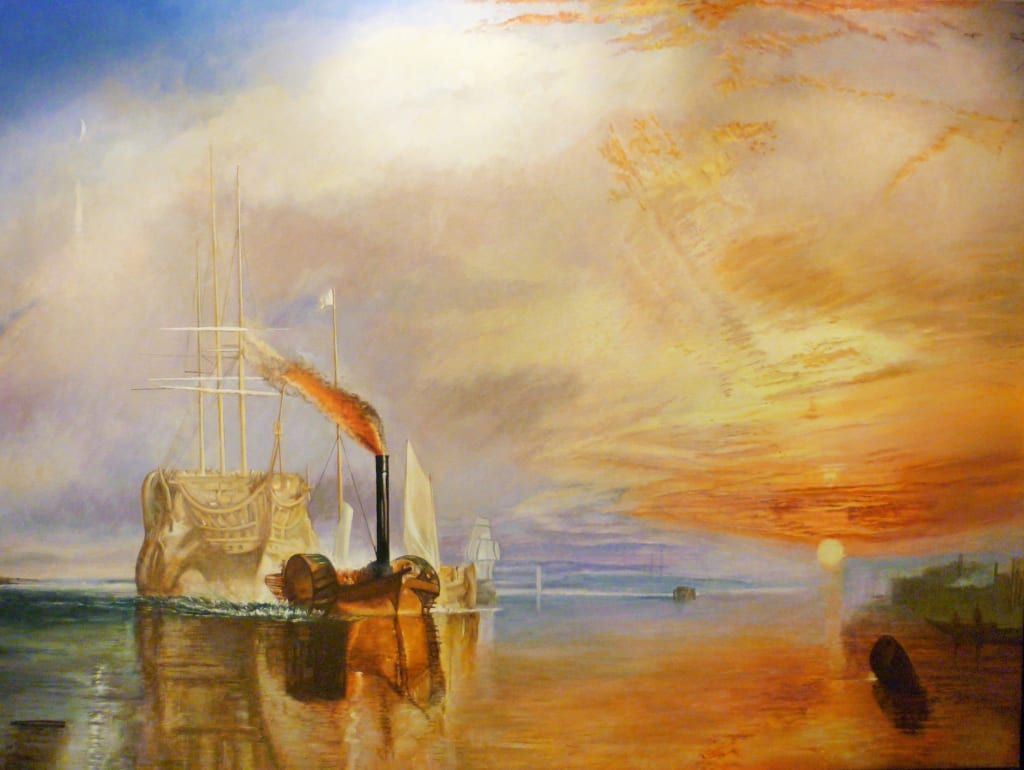"The Fighting Temeraire", by J M W Turner
A justly famed masterpiece

“The Fighting Temeraire” (the full title includes the words “tugged to her last berth to be broken up”) is possibly the best-known painting by JMW Turner (1775-1851) and is one of the major attractions of the National Gallery, London. It is a masterpiece of light and colour, and one of the most atmospheric works of art ever committed to canvas.
The painting commemorates a great “ship of the line” that played an important role in the Battle of Trafalgar in 1805 alongside HMS Victory. However, Turner’s painting shows this warrior in her last days, being hauled up the Thames for the final time, to be broken up at Rotherhithe. Turner witnessed this event in 1838 and his painting was created shortly afterwards.
HMS Temeraire had quite a short life, being built in 1798 to carry 98 guns, thus counting as a “second-rate” ship of the line, although the term did not imply any sense of inferiority when used in naval parlance. Temeraire’s role at Trafalgar was vital, coming to the rescue when it looked as though Victory, Nelson’s flagship, might be boarded. Nonetheless, by 1838 there was little call for massive three-masted sailing ships in the British Navy, and Temeraire’s fate was sealed.
Turner’s painting shows Temeraire under tow by a much smaller steam tug, fiery smoke belching from its funnel. By contrast, the huge bulk of Temeraire is ghostly pale in the background, her empty masts pointing high into the sky and the yards catching the light of the evening sun.
The river is a flat calm, broken only by the ripples made by the approaching tugboat. Both ships are reflected in the water.
The painting is almost two paintings in one, because the left half is occupied by the ships and the right by the setting sun that reddens the clouds through which it appears to fall and also throws a reflection on the water. The two halves could almost work on their own, because the eye is taken in both directions. However, the dying sun and the dying ship are meant to be seen together. We know that the sun will return, but the ship never will.
Anyone who knows the geography of the River Thames will soon appreciate that there is something very odd about the composition of this painting. If Temeraire is being towed up-river, as she clearly is, the vessels must be proceeding east to west. So how come the sun is setting in the east and not the west? Try as one likes, there is no getting round this, because the background detail is definitely of the distant open sea, with other ships far away on the horizon. Seen on its own, the sun could be setting in the west, as the buildings that one can see on the right-hand edge of the painting look like the spires and towers of central London, but, if this is so, one has to visualise the scene as a 180-degree diorama with the central part missing.
However, to cavil about geographical accuracy is to miss the point of Turner’s message. The former age is dying with the outmoded ship defeated by time. The future lies with the dirty, smelly and dark steam tug and not the graceful and ethereal Temeraire. The atmosphere is calm, but one can virtually hear the noise of the tug, which is annoying as it does not belong in this peaceful scene. One remarkable thing about Turner’s great paintings is that you can hear them as well as see them. His storms howl and whistle, and so does that wretched tugboat!
“

The Fighting Temeraire” is a supreme example of how light and colour can induce mood and atmosphere. The colour of the sky above the setting sun is the same as that of the fire belching from the tugboat’s funnel, but the former gives a feeling of peace and serenity and the latter is pure anger. The tugboat intrudes but Temeraire melts into her surroundings. The great ship has almost been swallowed up by the sky and the sea, and we feel that this would be a more fitting fate than the one that is about to befall her.
This is a painting to which no reproduction can do justice, as it has to be seen in the “flesh” to fully appreciate it. For one thing, Turner used a variety of techniques to achieve the textures that cannot easily be seen in a colour print. Paint was applied conventionally by brushes and palette knives but also by pieces of rag, the wrong ends of brushes and by the artist’s bare hands. These are techniques that we think of as being remarkably modern, but Turner used them way back in the 1830s.
We know that “The Fighting Temeraire” was a particular favourite of Turner’s and he refused many offers to sell it. It formed part of his bequest to the Nation when he died in 1851 and has never been in private hands. In 1839 he exhibited it at the Royal Academy with the caption: “The flag which braved the battle and the breeze no longer owns her”. We Brits are fortunate, as a nation, to own this wonderful painting as part of our national heritage.
About the Creator
John Welford
I am a retired librarian, having spent most of my career in academic and industrial libraries.
I write on a number of subjects and also write stories as a member of the "Hinckley Scribblers".






Comments
There are no comments for this story
Be the first to respond and start the conversation.